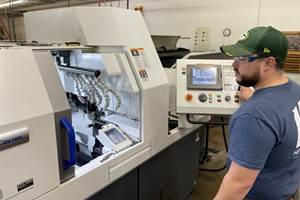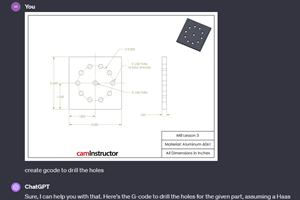An Indexable Insert
The solid end mill is a machine shop staple. Its positive cutting edge removes metal by slicing through the material, rather than by scraping.
Share






The solid end mill is a machine shop staple. Its positive cutting edge removes metal by slicing through the material, rather than by scraping. This reduces cutting forces, power required to make the cut and the possibility of inducing vibrations. These reasons are why solid end mills remain popular for low-horsepower machine tools with limited structural mass to damp vibrations.
Solid end mills do require periodic regrinding, and there is a limit to how many times this can be done to a tool. As an alternative, manufacturers have designed indexable insert end mills with positive radial and axial rake angles to emulate the solid end mill's cutting action, while allowing insert indexing and changeout. Until recently, though, a key feature of the solid end mill—eccentric relief, or "margin"—has not been replicated in an indexable insert cutter.
Big Daishowa Seiki has developed what is says is the first indexable insert end mill to combine positive/positive rake angles with eccentric relief, a la the solid end mill. We had the opportunity to preview the company's Fullcut end mill while visiting its manufacturing facilities and technical center located on Awaji Island, just off the coast of Osaka, Japan. Now available in the United States from Big Kaiser, Big Daishowa's partner located in Elk Grove Village, Illinois, this end mill design combines smooth, low-force cutting with insert changeability, while eliminating regrinding.
Eccentric relief is the positively arched (convex) area behind the cutting edge, as shown on the right-hand image in Figure 1. The profile brings the insert's sharp cutting edge nearly even with the body diameter to provide greater edge support. Unlike a concave, negative profile with a high clearance angle that tends to cantilever the insert from the body, eccentric relief more effectively directs the forces from the cutting edge into the tool's body. This geometry is less likely to cause insert chipping, which is prone to occur at the start of a cut (when cutting forces are highest) or during interrupted cuts.
Lower cutting forces can permit higher speeds and feeds, without increasing the risk of chipping. The Fullcut's insert geometry allows for shoulder, slotting and facing operations, but it can't be used for Z-axis feeding operations, such as plunge cutting or boring.
The end mills range in diameter from 0.5 inch to 2.0 inch, with inserts tailored to each diameter to maintain proper geometry. Each insert can be indexed once. The end mills are available in straight shank and integral body designs (V-taper, HSK and Capto) for high rigidity.
Related Content
ERP Provides Smooth Pathway to Data Security
With the CMMC data security standards looming, machine shops serving the defense industry can turn to ERP to keep business moving.
Read MoreThe Power of Practical Demonstrations and Projects
Practical work has served Bridgerland Technical College both in preparing its current students for manufacturing jobs and in appealing to new generations of potential machinists.
Read MoreCan ChatGPT Create Usable G-Code Programs?
Since its debut in late 2022, ChatGPT has been used in many situations, from writing stories to writing code, including G-code. But is it useful to shops? We asked a CAM expert for his thoughts.
Read MoreContinuous Improvement and New Functionality Are the Name of the Game
Mastercam 2025 incorporates big advancements and small — all based on customer feedback and the company’s commitment to keeping its signature product best in class.
Read MoreRead Next
AMRs Are Moving Into Manufacturing: 4 Considerations for Implementation
AMRs can provide a flexible, easy-to-use automation platform so long as manufacturers choose a suitable task and prepare their facilities.
Read MoreMachine Shop MBA
Making Chips and 91ÊÓƵÍøÕ¾ÎÛ are teaming up for a new podcast series called Machine Shop MBA—designed to help manufacturers measure their success against the industry’s best. Through the lens of the Top Shops benchmarking program, the series explores the KPIs that set high-performing shops apart, from machine utilization and first-pass yield to employee engagement and revenue per employee.
Read MoreLast Chance! 2025 Top Shops Benchmarking Survey Still Open Through April 30
Don’t miss out! 91ÊÓƵÍøÕ¾ÎÛ's Top Shops Benchmarking Survey is still open — but not for long. This is your last chance to a receive free, customized benchmarking report that includes actionable feedback across several shopfloor and business metrics.
Read More





















